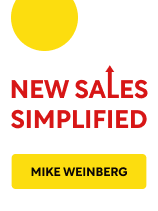

This article is an excerpt from the Shortform book guide to "New Sales Simplified" by Mike Weinberg. Shortform has the world's best summaries and analyses of books you should be reading.
Like this article? Sign up for a free trial here .
Do you struggle when it comes to cold calling? What can you do level up your cold calling game?
Few sales reps are proficient at or like making cold calls. According to sales expert Mike Weinberg, the key to cold-calling success is to start with the right mindset. Once you adjust your mindset and throw away any preconceptions, your cold calling success rate will improve tremendously.
Here are some expert cold calling tips from author and sales veteran Mike Weinberg,
Start With the Right Mindset
To set yourself up for success when cold calling:
1) Throw out your preconceptions and start fresh: When most salespeople make cold calls, they picture themselves as annoying telemarketers interrupting the prospect to pitch an unwanted product. Because what you believe affects how you act, having this negative image will undermine your sales efforts. Calling strategically selected targets who have problems that you can help them with is the antithesis of telemarketing. You’re a problem-solver. The fact that you have a valuable solution should make you want to call prospects.
2) Adjust your tone of voice and approach: In a few seconds of hearing your voice, a potential client forms an opinion about you. Too often, when making calls, salespeople sound like stereotypical salespeople—they speak in an unnatural “sales voice,” which raises a prospect’s resistance. Ask a colleague to listen as you make calls (when you’re unaware of it) to see if you’re speaking unnaturally. If you are, try to break the habit by practicing your pitch in a normal, comfortable voice. It’s better to be a bit informal than to be overly formal or respectful, which makes you come across as subservient. You’re an equal who has something to say that’s worth listening to.
3) Stop procrastinating by spending unnecessary time re-qualifying prospects: If buyers are on your prospect list, you’ve already selected and vetted them (qualified them) as people who could benefit from your solutions. Focus on your objective, which is getting a meeting with them, not on second-guessing your selection. The key to generating new business is action—getting in front of potential customers.
Try These Cold-Calling Techniques
Here are the key steps for planning and conducting prospect calls:
Step 1) Create a call outline and talking points: You don’t want to use a canned call script like a telemarketer would use—however, you need to know what you want to say and say it in a logical order. Also, having a consistent approach for all prospect calls is important—you can’t tell what’s working and not working if every call is different.
Step 2) Focus on the objective: Before making a call, you should know why you’re calling and what outcome you want (your objective). If you don’t know these things, it’s easy to get sidetracked when the prospect raises questions or objections. You need to keep steering the conversation toward your objective.
Your objective is:
- If you’re an inside salesperson: to set the stage for having a full sales conversation where you structure the dialogue—either during the immediate call or scheduled for a later time
- If you’re an outside salesperson: to get a face-to-face meeting with the prospect
Step 3) Develop a useful, effective introductory phrase: Weinberg likes to use “Let me steal a minute” and an introductory phrase. When you say, “Let me steal a minute,” you’re acknowledging, but not apologizing for, interrupting.
After your introductory phrase, identify yourself by saying, “I head up the western region for Acme company” or “I head up client relationships for Acme.” Saying that you “head up” an area of responsibility underscores that you’re an important person who’s worth listening to.
Step 4) Write a mini-sales story: To start the dialogue, create and use a condensed version of your sales story that will pique the prospect’s interest in having a face-to-face meeting with you. To position yourself as someone that people in the prospect’s industry turn to for help with challenges, focus on a few client issues from the sales story: a unique, intriguing issue and a widely applicable issue. Also, choose one differentiator from the sales story.
Present the issues and differentiator in a conversational way—for example: “Right now many property managers are looking for a security team that projects a professional image.” Pause and wait for a response. Based on the response, mention another issue, describe a differentiator, or ask for a meeting.
Inside sales reps will need to create a segue or bridge to the structured sales conversation (since you’re not asking for a meeting). One way is to ask a few simple probing questions and listen carefully to the answers in order to uncover sales opportunities. Learn all you can about the prospect’s situation and note anything that might be useful later.
Step 5) Ask three times for a meeting: There’s a good chance the prospect will say no your first request for a meeting. It’s automatic, so don’t take it personally. The important thing is, don’t hang up. If you give up on a prospect after one rejection, you’ll fail and keep failing. The third time you ask is usually when you’ll be successful.
Weinberg uses three words repeatedly when asking for a meeting:
- Visit: A visit sounds friendlier and less formal than an appointment or meeting, as in: “I’d like to visit with you,” or “Would you have 20 minutes to visit with me next Wednesday or Thursday?”
- Fit: This is a non-threatening word that demonstrates confidence on your part, as in: “Let’s talk about how our company might be a fit for your needs.”
- Value: All customers want value. Ways to use this word include: “We’ll review your information and see whether we can bring value to your situation” and (when you’re asking a second time for a meeting) “I promise that you’ll get value and ideas from our conversation.”
Be Prepared for Resistance
Everyone, sales reps included, resists salespeople—it’s an automatic negative reaction to past experiences with pushy salespeople, or stereotypes about the profession. For example, consider the common put-down that someone is like a “used car salesman,” meaning manipulative, annoying, untruthful, a fast-talker, and a poor listener.
To avoid reinforcing this stereotype and undermining your effectiveness, think about how you come across. Ask yourself:
- How will this interaction leave the customer feeling about me and my company?
- What message am I sending about what it will be like to work with me?
- How can I show that I’m focused on the customer’s needs rather than self-focused?
- How can I show I’m worth the customer’s time (that I’ll provide value)?
Ways to Minimize Buyer Resistance
Your beliefs, what you say and sound like, and how you feel about prospects can exacerbate buyer resistance unless you adjust them.
- Your beliefs: Your beliefs about yourself and your offerings affect the way buyers see and react to you. If you’re insincere or unenthusiastic, they’ll detect it and respond defensively. In contrast, when you’re motivated by a belief that you can truly help customers and a desire to do so, they’ll sense it and respond positively.
- How you sound: As previously noted, make sure you’re not using an unnatural “sales voice” (sounding like a TV pitchman) that generates resistance. Speak normally and confidently.
- How you feel about the prospect: Many reps have two self-defeating beliefs about prospects: 1) they don’t treat prospects as “serious” leads with strong potential to become customers, and 2) they assume potential customers will be interested only in price-shopping or getting the cheapest deal. Reps telegraph such negativity and frustration to customers, which generates resistance. In contrast, reps who are optimistic and see sales leads as opportunities to win new business project confidence and are usually successful.
- What you say: If you’re self-focused and only talk about how great your company is, prospects will resist you, as they do all salespeople they want to avoid. To avoid automatic resistance, you must start with the client’s issues.
Take Advantage of Voicemail
As a salesperson, you’ll end up in voicemail about 75% of the time. Here are some cold calling tips on how to use voicemail to your advantage:
- Be positive rather than discouraged about having to leave a message: You’ll need multiple contacts to connect with a prospect, so treat this as the first opportunity.
- Expect to end up in voicemail: Be prepared to leave an articulate message.
- Draw from your sales story: Cite one or two client issues to intrigue the prospect.
- Treat the first voicemail as one in a series: Few people call back after one message, so plan to keep calling. Use a different piece of your sales story in each message.
- Ask for a return call, and say you’ll call again. Leave your number and ask to be called back. Say that you’ll call again. Calling again shows you’re serious about connecting with the prospect—he’s a priority.
Use humor or guilt to sound human: Sound like a real person with feelings, not a robocaller. You’re more likely to get a response if you’re making a real effort. After several calls, your message might start, “I hope I haven’t worn out my welcome …” The third voice mail (like the third ask) often works.

———End of Preview———
Like what you just read? Read the rest of the world's best book summary and analysis of Mike Weinberg's "New Sales Simplified" at Shortform .
Here's what you'll find in our full New Sales Simplified summary :
- A step-by-step plan for strategically selecting sales targets
- How to develop sales weapons
- How to consistently generate new sales






